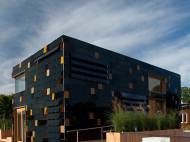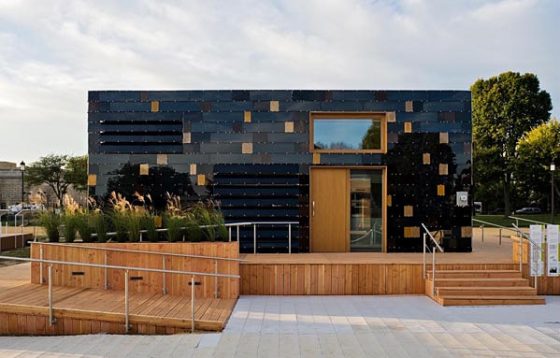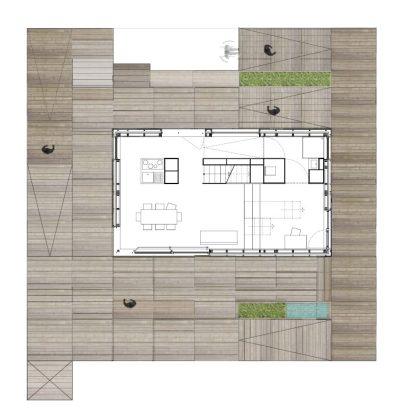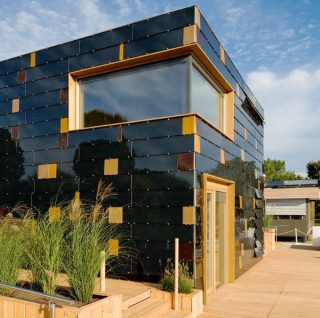Team Germany wins Solar Decathlon 2009
 “Team Germany” from the Technische Universität Darmstadt has won the 2009 Solar Decathlon with their project surPLUShome. This is the second time in a row that a team from TU Darmstadt wins this international contest after already winning the title in Solar Decathlon’s last edition in 2007. After 9 days and 10 contests, Team Germany reached the highest overall scores, closely followed by Team Illinois and Team California. Dubbed “the big, black monolith,” surPLUShome is almost entirely covered with photovoltaic panels that managed to generate 19 kilowatts during one day of test runs (more than twice as much as some other Solar Decathlon contestants).
“Team Germany” from the Technische Universität Darmstadt has won the 2009 Solar Decathlon with their project surPLUShome. This is the second time in a row that a team from TU Darmstadt wins this international contest after already winning the title in Solar Decathlon’s last edition in 2007. After 9 days and 10 contests, Team Germany reached the highest overall scores, closely followed by Team Illinois and Team California. Dubbed “the big, black monolith,” surPLUShome is almost entirely covered with photovoltaic panels that managed to generate 19 kilowatts during one day of test runs (more than twice as much as some other Solar Decathlon contestants).
The Solar Decathlon is a competition in which 20 teams of college and university students compete to design, build, and operate the most attractive, effective, and energy-efficient solar-powered house. The contest is also an event to which the public is invited to observe the powerful combination of solar energy, energy efficiency, and the best in home design. The Solar Decathlon design of the Darmstadt University of Technology aimed to demonstrate innovative sustainable design and to make it an object of discussion. Their architectural vision offers a lifestyle which introduces the concept of energy efficiency and sustainability as a significant element of everyday life.
The interior concept consists of a single room for maximum space and flexibility. Because of the different occasions and the need for different degrees of privacy in single roomed object, the east side floor (bedroom) has been lowered while an open gallery above offers additional isolated space for leisure. The “multifunctional body” in the northern part of the building integrates several basic and everyday functions: kitchen, bathroom, stairs, storage space and building services. It is the center piece of the design and plays an important role in defining different zones of the building. The functions are stored away into cabinets and cavities, making the main room opened and flexible to provide adequate space for different activities.
The integrative designs of furnishings such as the bed which can be stored away beneath the flooring are essential to preserve the room qualities. The choice of interior materials supports the overall idea of a light and airy feeling. Light colors on the walls contrasts to a structured wooden flooring. The functional body attains its solitaire character by the glossy acrylic glass surface. Windows are placed to support the different functions and ambiences of the room and allow different views.
The construction of the façade is based on the traditional principle of shingles, which is commonly practiced with slate or wooden plates. They picked up that technique and transferred the principle onto a new appearance and modern materials such as glass PV-modules and acrylic glass. The façade-system achieved accordance to all various requirements of building façades. Besides the architectural claims, it also features constructive moisture proof and technical exhaust ventilation. Furthermore the façade offers effective shading and lighting control system all in one. In order to generate an energy gaining façade that functions in all orientations they used thin-film CIS cells which are characterized by the ability to function with diffuse solar radiation.
In order to reduce the energy demand, the building shell consists of highly insulated and airtight components, Vacuum Insulation Panels (VIP). A vacuum insulation panel with a width of 5cm has the equivalent insulation properties of 25cm of common insulation materials. As a result the extra 20cm were added to the interior space. Additionally the complete building can is reduced to a surface area of approximately 2 square meters.
Wood is a renewable resource with positive life cycle assessment. To reduce the ecological impact of the building, they decided for a wooden primary construction. As strong but light material it offers high material efficiency. Furthermore it has high heat storage properties. Therefore, the use of local wood (spruce for construction and ceiling, oak for flooring and frames) was increased.












Leave your response!